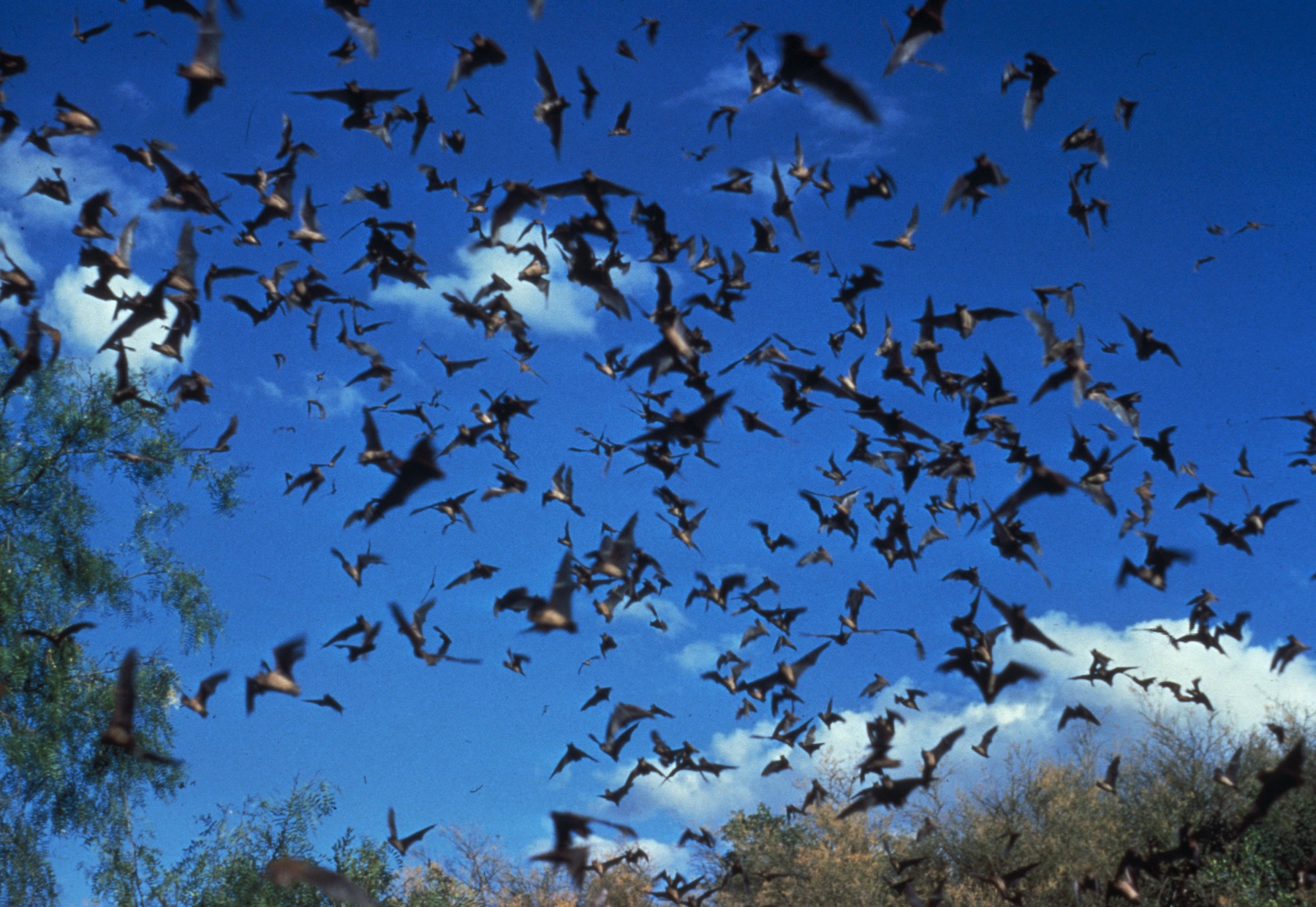Bats and zoonotic viruses

Coronaviruses and bats
SARS-CoV-2 is a coronavirus that infected a human for the first time in the autumn of 2019. We believe this virus originated in some kind of bat because its genetic sequence is most similar to a coronavirus found in bats. SARS-CoV-2 itself has not been found in a bat, so the virus might not have jumped straight from bat to human. As was the case with the original SARS-CoV, the virus may have mutated in an intermediate animal host before launching a career as a human pathogen. For the original SARS, the animal was probably a palm civet; for MERS, another zoonotic coronavirus, it’s camels. (Click for detailed chapter on the emergence of SARS.) For the new coronavirus, the intermediate animal host is not yet known. Early, attention turned to pangolins but that theory has not held up.
Bats are an unusually frequent source of zoonoses: diseases that spread from an animal to humans. Why?
Bats are singular creatures in many ways. Most obviously, bats are the only mammals that fly. This extraordinary feat of evolution is so powerful and useful that there are more species of bats than any other mammal on earth–somewhere in the range of 1,400 different bat species, or about 20-25% of all mammal species in existence. On top of bats’ unique ability to fly, they are the only land mammals with advanced, precise echolocation. They use sonar to see in the dark. Furthermore, they live in vast, densely populated colonies that for other mammals (like humans) would be brought down by infectious disease.
These astonishing features of bats should alert us that they may also be unique in less-obvious ways. One of those ways is their immune system. And we are barely beginning to learn about this.
What we do know is that healthy bats carry a lot of different viruses that would kill other animals. Somehow, the supercharged bat immune system keeps deadly viruses in check without exterminating them. Bats carry the viruses, and the viruses do not make them sick. In this ongoing state of truce, a disruption such as stress on the bat can lead to bursts of virus replication, and spillover of viruses into the environment. Which raises the possibility that human encroachment on bat habitat not only brings the two species in closer contact, but could actually trigger a release of viruses.
How should humans respond to this information? Sadly, some humans are responding by killing bats and bat colonies. In response to this fear-driven violence, a local bat expert wrote a brief essay which I have reproduced below with her permission. Corky Quirk is known in the Sacramento-Davis region as “the bat lady.” She is founder of NorCal Bats and affiliated with the Yolo Basin Foundation, which in normal times leads bat talk and walks to witness the Mexican freetail bat colony that lives under the Yolo causeway in the summer.
Before turning it over to Corky Quirk, I’ll point out that the peculiar features of bat immunity are obviously a threat in terms of viral spillover and zoonoses, but they are also an incredible opportunity. If we can decipher what is special about how bats manage their virus load, imagine what new immunotherapies we might discover for human medicine.
“Bats have emerged as important reservoirs of zoonotic viruses that cause serious disease in humans and other animals with no visible clinical signs of disease in bats. This has prompted scientists to study the evolution of antiviral responses in bats to understand their ability to tolerate infections with viruses that are lethal in other mammals.” Source
Respect, don’t fear, bats
By Corky Quirk, Yolo Basin Foundation / NorCal Bats
Worldwide, bats fill many niches in the ecosystem from insect control, to pollination, to seed dispersal. Some of these tasks are important to human agriculture. Of the 45 species of bats in the United States, all eat insects or other invertebrates. In the southwest deserts there are a couple of species that also pollinate cactus.
Humans live and work among bats. They are in buildings. They are in caves where people recreate and where guano is collected for fertilizer. In tropical areas they hang in trees in neighborhoods and villages. Although a bat may harbor a disease, transmission is rare. These transmissions happen due to human behavior. For example, in the United States we worry about the rabies virus. Rabies is passed through saliva, so one must handle a sick bat to be at risk.
There are many suggestions about how zoonotic diseases make the jump to humans; all point to human behavior. Deforestation, degradation of habitat, capturing wildlife for the exotic pet trade, mixing captive wildlife and domestic animals in confined areas. All these lead to stress and the shedding of viruses. This, coupled with our ability to quickly travel longer distances, even crossing oceans, increases the rapid spread. Also, we can’t underestimate human population growth. In 1950, there were approximately 2,600,000,000 people on earth, now there are about 7,800,000,000 people.
Even if horseshoe bats are found to be the reservoir for this current coronavirus, there is no reason to fear bats. They are amazing mammals whose bodies have adapted to live with certain viruses. There is no evidence that suggests bats of North America harbor these types of coronaviruses.
Human fear is a huge enemy to the bat. We fear what we don’t understand. When afraid, people act before thinking. NorCal Bats, in Davis, has received several calls from people worried that the bat they saw near their home will pass Covid-19 to them. This is not how the virus spreads.
Bats are fascinating mammals with many special adaptations that help them live their nocturnal, insect eating lifestyle. In the summer, Mexican free-tailed bats of the Yolo Causeway consume about 500 grocery sized bags of crop pests and mosquitoes nightly. They fly fast, they fly high, they echolocate, they nurse their young, and every night, all summer long, they fascinate us as we watch them fly out over the wetlands. We hope you can join us this summer, learn more about the bats, and enjoy watching them fly.
Amy Rogers, MD, PhD, is a Harvard-educated scientist, novelist, journalist, and educator. Learn more about Amy’s science thriller novels, or download a free ebook on the scientific backstory of SARS-CoV-2 and emerging infections, at AmyRogers.com.
Sign up for my email list
0 Comments
Share this:



0 Comments